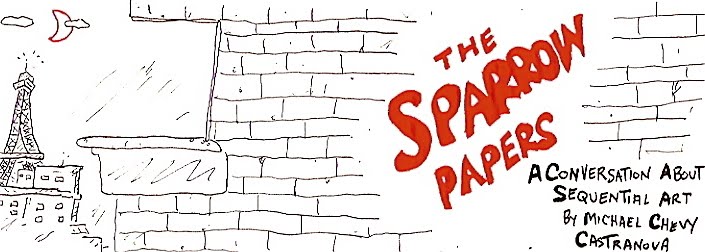 The way Seth works his magic is with silence. It’s how he controls pacing. Here’s an example, from pages 123 through 128 of the paperback edition of his first book, It’s a Good Life, If You Don’t Weaken:
The way Seth works his magic is with silence. It’s how he controls pacing. Here’s an example, from pages 123 through 128 of the paperback edition of his first book, It’s a Good Life, If You Don’t Weaken:As Seth and his friend Chet walk along a Toronto street, he bemoans his most recent breakup with a girlfriend, Ruthie. Seth and Chet stop at a tall building, which Seth notes looks “pretty … against the night sky.” In the next panel, we see the building, set against the stars.
“There’s something in the decay of old things that provokes an evocative sadness for the vanished past,” Seth says, and proceeds to ruminate on the value of lost things, on the quality of old things well made. He speculates his continuing search to track down a one-hit-wonder New Yorker cartoonist, Kalo, might be in vain and pointless.
We’re shown the building again. In the next panel, we see stars in an otherwise barren sky. Then a wider panel of other city buildings.
Next, with no fanfare, a flashback, across a two-page spread: Seth breaking up with Ruthie, and not doing it well. “You’ll regret this later,” she promises, unsmiling. “Trust me.”
Then, present day, as Seth sits in his apartment petting his cat. We see his rotary-dial telephone next to an opened phone book. Then he dials, and waits. He asks for the number of real estate office in Strathroy, another step in his quest to find Kalo.
Then a wide panel across the bottom of the page, showing that building again, and with the other buildings around it, at night.
This reminds me of what movie director Michelangelo Antonioni did in his famous trilogy from the early 1960s. Watch Jeanne Moreau walking around near the beginning of La Notte — the scene continues for long minutes, without dialog, as she and the camera look up at buildings, along empty streets, the heels of her shoes echoing. Silence and thought.
Later, on page 134’s final two panels, Seth tells us, “… It was crazy to think I could find Kalo. Only now, after studying tons of old magazines, can I see that there are literally hundreds of obscure cartoonists — any of whom could have sold, through a stroke of luck, a lone gag to The New Yorker.” (He does keep searching.)
Those panels show us a long shot of small, dark houses, few lights on in their tiny windows, peeked at through tree branches and illuminated only by moonlight. Silence and thought.
See my earlier post on this book here.

No comments:
Post a Comment